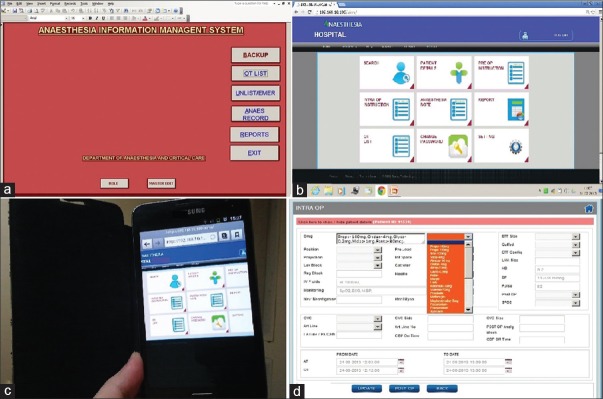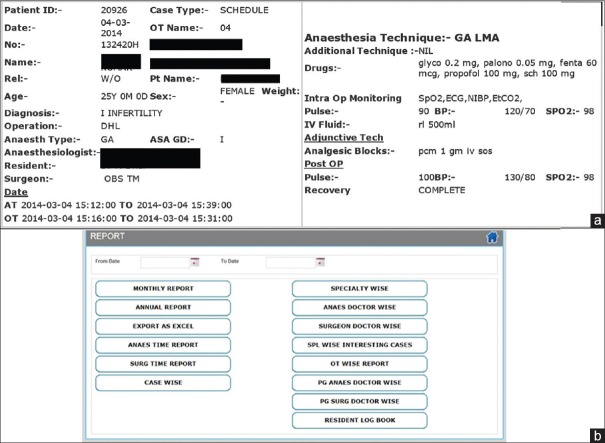INTRODUCTION
Traditional techniques of record keeping in most hospitals include manual entry in case sheets and then adding to piles of paper files.[1] Although gradual transition towards automated and computerized record systems is in place, it is still a distant prospect in many peripheral institutes and low resource hospitals. An anaesthesia information management system (AIMS) is an electronic record system that allows collection, storage and presentation of patient data during the peri-operative course.[2] Our institute is a research oriented referral institute and we have designed a low cost model of an AIMS, which can be customized to local needs. We briefly describe the process and evolution of this recording system in our anaesthesiology department and operation theatre complex, its effect on the staff including the doctors, nurses and technicians and how it can be incorporated on a wide scale to other institutes and hospitals, where modern, automated and technology heavy systems[2,3] will take time to establish.
METHODS
The AIMS was first initiated in our department as a small ‘Structured Query Language’ based software which involved data entry of peri-operative patient details including anaesthesia notes. It was developed in association with a local software engineer with basic knowledge of data management systems. Initially there was a single computer allocated for this purpose which fulfilled both requirements of data entry to generate Operation Theatre (OT) lists to begin with and also anaesthesia note entry by the resident later [Figure 1a]. There was understandably a rush for the computer at the end of the day in an effort to complete all data entry duties in time. Although it met with a bit of resistance initially, from both anaesthesia residents and OT technical staff as it involved work to be done out of routine, it gradually became a part of the normal OT schedule.
Figure 1.
(a) Initial basic version of software, (b) advanced version of software with user friendly interface, (c) data entry on personal devices through wi-fi, (d) drop down menus for easy data entry
Feedback from staff and changes in the software led to a more user friendly interface with more options and uses [Figure 1b]. Preparation of OT lists was more streamlined wherein all surgical departments could send their cases via an extension of the software from their respective departments and it all culminated into a final OT list for the next day.
Based on time management problems encountered by the residents, a local area network incorporated with a wi-fi was also established into the software. The software could now be accessed through personal devices enabled with wi-fi connectivity and the residents could enter data anywhere in the OT complex at their leisure [Figure 1c]. This also led to better security of the data as the main/chief data entry computer was isolated only for administrative work which required authentication via a password. Consultant and residents had their own accounts to enter data. Once entered, administrative permission was required to edit data.
Data entry itself was made faster and more convenient with drop down menu options of drugs, doses, anaesthetic techniques and procedures performed [Figure 1d]. The final OT note appeared in a summarized form [Figure 2a]. Other options or information which could be derived from the software included an audit of the monthly or yearly workload, doctor-wise cases and generation of log book for post-graduate residents [Figure 2b].
Figure 2.
(a) A completed final data sheet of the patient, (b) retrieval of varied data, including log book
Since the 3 years of its inception it has now evolved into a robust, low cost and locally modifiable data entry and management system, with the potential for further improvements.
DISCUSSION
A common source of weakness in an anaesthesiologist's defense during litigations is usually incomplete and illegible notes, along with the use of confusing abbreviations.[4] An anaesthesia record is a continuous detailed account of what took place during the course of the treatment/management of the patient which meets both demands, clinical and medico-legal. In this context an AIMS is the future of record keeping as we are progressing from digitalization of data to automation of data.[2]
The main advantages of an AIMS is that it enhances the quality of records, allows analysis of variations in the practice of anaesthesia by individual physicians and storage in a digital format which can be easily shared among departments or even institutions.[5] Automated records have the potential to contain more data than manually kept records. And as the data is continuously available, it is sampled more frequently. Errors of manual documentation (observer bias, missed readings, errors of memory, manipulation of data, illegible entries, misplaced records and inability to retrieve data) are avoided.[3,5]
These systems can convert large volumes of data into usable and reproducible information for research and quality-improvement purpose.[6]
An estimated 5% of United States operating rooms had an AIMS in 2006 which has increased to 44% recently.[7] In India this technology is relatively new, although its use is increasing.
Many advanced and expensive AIMS software are now available in the market.[2] Modern day workstations have an AIMS as part of the structure with a touch screen display and also a keyboard for data entry. They record the intra-operative details including monitoring data continuously for review later. Although technology wise these are much more advanced than the system described by us, the latter not offering continuous vital recording facility as of yet, the point we emphasize is that proceeding towards automation of records does not need to start with these systems straightaway, as the initial bulky start-up costs might deter hospitals from even beginning the process of digitisation of information. Our AIMS was developed locally with a help of a programmer and was modified at each step according to end-user feedback. This was a cost effective, robust and multipurpose system. Initial start-up cost, subsequent modifications, additions and troubleshooting costs including cost of the back-up server were nominal. There were no significant maintenance costs.
A review of AIMS describes that the ‘processes and precautions, appropriate selection, installation and implementation of AIMS are complex, but are learned at each site by trial and error.’[8] We too have tried to improve and improvise at each step of the software development, and we wish to showcase it as an example to other peripheral and low resource hospitals where it can be easily established into routine practice.
The impact of an AIMS on patient care is a more informed manner of working and allowing the anaesthesiologist to focus more on the patient rather than record keeping.[9]
Its impact on practice of anaesthesia is increased quality and functionality, assessment of individual outcomes, integration with other hospital data-bases and legal protection in the form of accurate, un-biased information. It also serves to supplement educational purposes including retrospective study of interesting cases.[2] As the scientific community is now transitioning from eminence to evidence based medicine, it becomes a valuable tool in audit and research related purposes. Lastly its impact on the management, wherein tabulating services, number of cases, costs, systematic analysis of drugs and supplies and appropriate resource utilization is also possible.[2,3] The vision is thus to provide each OT with a desk top and local area network connection for real time data recording, integrate medical store inventory and move towards a paperless documentation.
CONCLUSION
Use of AIMSs are increasing in view of the decreased cost of such systems, increased functionality and also increasing pressure to report data for external review or medico-legal purpose. We have tried to develop a low cost, customized and tamper proof database management ‘system in evolution’ which may serve as an example to other peripheral hospitals for possible incorporation into their clinical practice.
Financial support and sponsorship
Nil.
Conflicts of interest
There are no conflicts of interest.
REFERENCES
- 1.Anderson BJ, Merry AF. Paperless anesthesia: Uses and abuses of these data. Paediatr Anaesth. 2015;25:1184–92. doi: 10.1111/pan.12782. [DOI] [PubMed] [Google Scholar]
- 2.Ehrenfeld JM. AIMS, a guide to their successful installation and use [monograph on the Internet] Anaesthesiol News 2009. [cited 2016 Jan 31]. Available from: http//www.anesthesiologynews.com/Review-Articles/Article/09-09/Anesthesia-Information-Management-Systems-A-Guide-to-Their-Successful-Installation-and-Use/13773 .
- 3.Rothman B, Leonard JC, Vigoda MM. Future of electronic health records: Implications for decision support. Mt Sinai J Med. 2012;79:757–68. doi: 10.1002/msj.21351. [DOI] [PubMed] [Google Scholar]
- 4.Bateman ND, Carney AS, Gibbin KP. An audit of the quality of operation notes in an otolaryngology unit. J R Coll Surg Edinb. 1999;44:94–5. [PubMed] [Google Scholar]
- 5.Bajwa SJ. Amalgamation of management information system into anaesthesiology practice: A boon for the modern anaesthesiologists. Indian J Anaesth. 2014;58:121–6. doi: 10.4103/0019-5049.130803. [DOI] [PMC free article] [PubMed] [Google Scholar]
- 6.Kadry B, Feaster WW, Macario A, Ehrenfeld JM. Anesthesia information management systems: Past, present, and future of anesthesia records. Mt Sinai J Med. 2012;79:154–65. doi: 10.1002/msj.21281. [DOI] [PubMed] [Google Scholar]
- 7.Epstein RH, Vigoda MM, Feinstein DM. Anesthesia information management systems: A survey of current implementation policies and practices. Anesth Analg. 2007;105:405–11. doi: 10.1213/01.ane.0000270214.58811.c4. [DOI] [PubMed] [Google Scholar]
- 8.Muravchick S, Caldwell JE, Epstein RH, Galati M, Levy WJ, O'Reilly M, et al. Anesthesia information management system implementation: A practical guide. Anesth Analg. 2008;107:1598–608. doi: 10.1213/ane.0b013e318187bc8f. [DOI] [PubMed] [Google Scholar]
- 9.Devitt JH, Rapanos T, Kurrek M, Cohen MM, Shaw M. The anesthetic record: Accuracy and completeness. Can J Anaesth. 1999;46:122–8. doi: 10.1007/BF03012545. [DOI] [PubMed] [Google Scholar]




